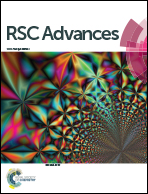A facile approach for the synthesis of novel 1-oxa- and 1-aza-flavonyl-4-methyl-1H-benzo[d][1,3]oxazin-2(4H)-ones by microwave enhanced Suzuki–Miyaura coupling using bidentate chromen-4-one-based Pd(ii)–diimine complex as catalyst†
Abstract
A facile access to diversely substituted 1-oxa- and 1-aza-flavonyl-4-methyl-1H-benzo[d][1,3]oxazin-2(4H)-ones using the microwave assisted phosphine-free Suzuki coupling of bromo flavones with boronic acids using a chromen-4-one-containing Pd(II)–diimine complex (C) as catalyst under aerobic conditions is reported. A small amount of the catalyst (0.3 mol%) was found to be highly effective for coupling to form the products in very high yields in 18–20 min under mild reaction conditions. This catalytic system is compatible with a broad spectrum of olefinic or aryl bromide and aryl- or heteroaryl-boronic acids. After screening various catalytic conditions, it was found that a Pd complex of the bidentate Schiff base ligand was able to efficiently catalyze these reactions with yields up to 95%. The effect of solvent, base and catalyst loading on the coupling reaction is also described.
![Graphical abstract: A facile approach for the synthesis of novel 1-oxa- and 1-aza-flavonyl-4-methyl-1H-benzo[d][1,3]oxazin-2(4H)-ones by microwave enhanced Suzuki–Miyaura coupling using bidentate chromen-4-one-based Pd(ii)–diimine complex as catalyst](/en/Image/Get?imageInfo.ImageType=GA&imageInfo.ImageIdentifier.ManuscriptID=C5RA15274G&imageInfo.ImageIdentifier.Year=2015)

 Please wait while we load your content...
Please wait while we load your content...